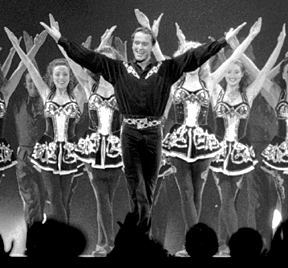 |
The Lord
of the Dance |
|
The reason we go to see Lord of the Dance is to get a taste of Ireland. Its mystical appeal has long been evoked by soulful ballads that tear at the emotions and bearded men who fiddle away at notes of a simpler, happier life. And now Michael Flatley's show has thrust the the arm-in-arm Irish jig into the mainstream of Irish cultural symbols. Millions more people have seen the show than there are people in Ireland, and its total revenue would make up nearly 0.5% of its GDP. In order to achieve such success, it has fused its traditional song and dance with the 'showbiz' of its cultural counterparts accross the Atlantic. Along with fiddles, tin whistles and and Irish singing, the show bosts explosive pyrotechnics, numerous flashy-sexy outfit changes, and laser-lights and booming sound-systems that would do Las Vegas proud. The female chorus members have perma-smiles, caked make-up and generally play the role of sexy cheerlearders. And the dancing itself is actually a fusion of ballet and modern dance along with traditional Irish jigging. One of the difficulties of the dancing style is that we get caught either trying to look at people's faces or trying to look at their quick moving feet. Their bodies don't really fuse into a single, expressive whole. But the combination is effective at points. In the show the 'good' dancers (dressed in light colors such as green) are confronted by the 'bad' dancers (dressed in black). The 'bad' men aggressively jig their way onto the stage, stomping their feet and thrusting their arms. The lead 'bad' woman seductively tempts the audience and the Lord of the Dance with impressive pirouettes and quick heels. But after a while, the expressive range of the jig feels limited. The 'good' men, including The Lord of the Dance himself, flutter about with some very impressive steps, but take away the 'bad' guys, and it all seems very elvish, happy and calm... that is, it seems stereotypically Irish - but not much else. Eventually, good and evil meet for a final dance-off, but the Lord of the Dance doesn't dance noticably better, just friendlier; the only way he wins his dancing title back is by dancing the bad guy into a big stage explosion. In this tale of good versus evil, evil ends up looking a lot cooler. It is true that the girls look sexy, the men's dances are impressive and the production is slick. And by the end, we do feel entertained, but also a bit empty: like its flashy exterior has come at the expense of that intoxicating combination of soulful sadness and earthen tranquility that was the real reason we came. Oliver Morrison, 23.6.4 |
|